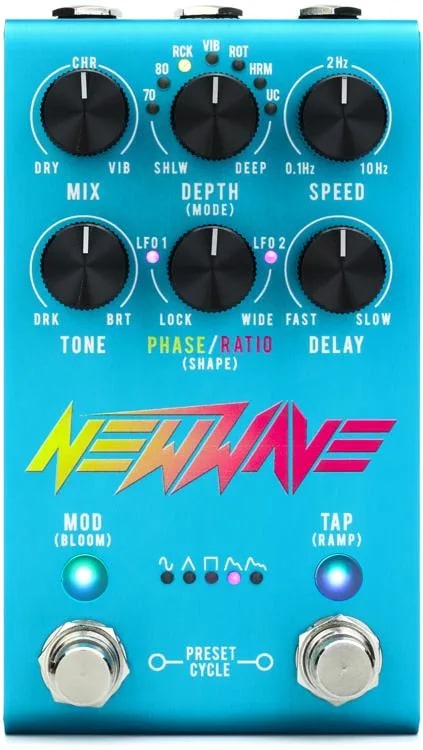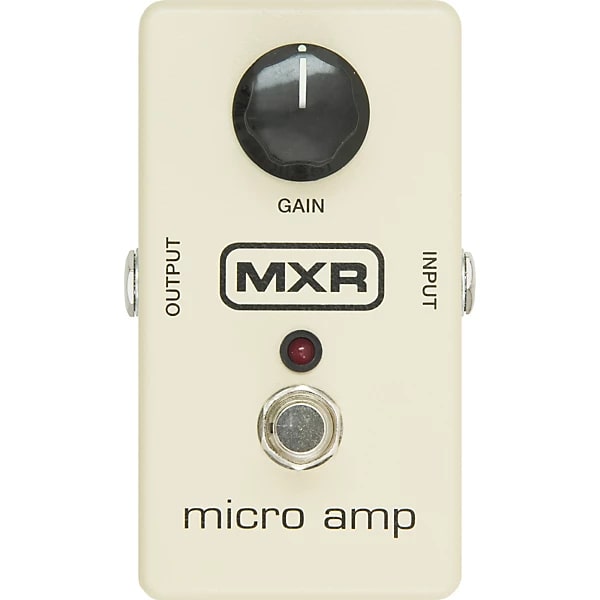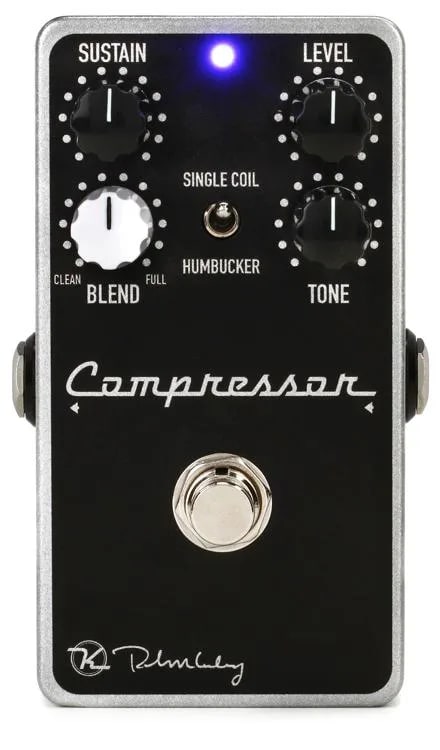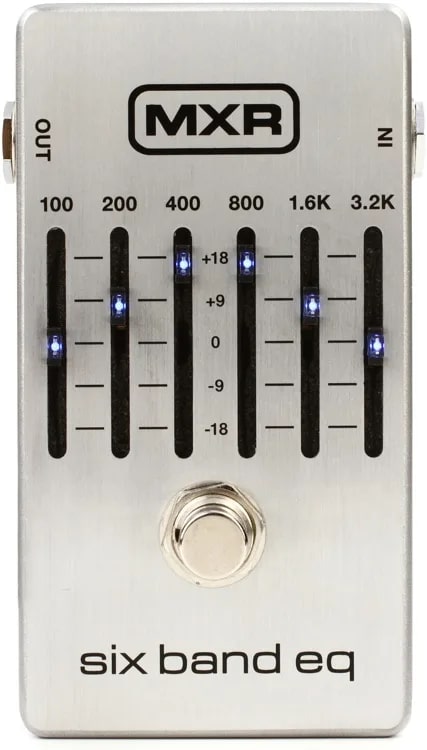When you buy through our links, we may earn an affiliate commission.
Whether you're just starting out on guitar or have some experience under your belt, you want the best guitar-playing experience you can get.
And whether you just want to have some fun, better express yourself through your instrument, or wow 'em at your live performances, there's no better vehicle than a good pedal.
Effects pedals can significantly alter your guitar's signal to the point of total transformation—no matter what your amp situation is or what electric guitar you're rocking, the right pedal can alter your sound to the point that you won't even recognize your old rig. There's nothing like it to reignite the flame.
That's why we've rounded up this list of some of the best guitar pedals on the market today. Whether it's something specific you have in mind or you're just looking for the next burst of inspiration for your pedalboard, our picks are sure to stoke your imagination and take your tone to the next level.
We've got picks for overdrive, delay, fuzz, reverb, and more! Plus, we've included a handy buyer's guide and FAQ section to answer any lingering questions about guitar effects pedals that remain.
Now, read on to discover the pedal that could change your life.
Quick Summary of the Best Guitar Pedals
- MXR Duke of Tone (Best Overdrive Pedal)
- Catalinbread Soft Focus Shoegaze Reverb (Best Reverb Pedal)
- Strymon TimeLine Multidimensional Delay Pedal (Best Delay Pedal)
- Ibanez Tube Screamer Mini (Best Distortion Pedal)
- Jackson Audio New Wave Stereo Analog Chorus/Vibrato Pedal (Best Chorus Pedal)
- Dunlop Cry Baby Mini Wah (Best Wah Pedal)
- Walrus Audio Eons (Best Fuzz Pedal)
- MXR Micro Amp (Best Boost Pedal)
- Keeley Compressor Plus (Best Compressor Pedal)
- MXR M109S Six-Band EQ (Best EQ Pedal)
Best Guitar Pedals
1. Best Overdrive Pedal – MXR Duke of Tone

SPECS
- Type: Analog Overdrive
- Bypass: True Bypass
- Power Requirements: 9V DC power supply
First up is our pick for the best overdrive pedal: MXR's Duke Of Tone, their take on the legendary King of Tone pedal.
This pedal comes to us courtesy of MXR's collaboration with Analog Man, which has graciously allowed us mere peasants to experience tone royalty for ourselves.
MXR's Duke of Tone circuit is basically one-half of the dual-channel King of Tone, one of the most sought-after overdrive pedals of all time.
Its three-way switch allows you to toggle between creamy sweet overdrive, a clean boost that's loaded with headroom, and an aggressive, harmonically rich distortion.
This killer overdrive was named the most versatile on our list of the best overdrive pedals for a reason. If you want an overdrive pedal that does it all, you've got to check out the Duke of Tone.
2. Best Reverb Pedal – Catalinbread Soft Focus Shoegaze Reverb

SPECS
- Type: Digital Reverb, modulation
- Bypass: Buffered
- Power Requirements: 9-18v power supply
If your amp already has a built-in reverb effect, you might want to check out a reverb pedal that does more than just, well, reverb. Enter the Catalinbread Soft Focus.
Based on a legendary multi-fx processor from the 90s, the Yamaha FX500, this pedal is designed to bring epic reverb and more to your pedalboard.
What you get is essentially a modified plate reverb that's split into three signal paths: reverb, reverb with octave up, and reverb with chorus.
The controls are very intuitive: simply dial in your level of octave, chorus, and reverb, mix in the effects to your liking, and boom—instant shoegaze tone. And if it's just a touch of 'verb you want, no problem—simply dial down the octave and chorus, roll the mix knob on just a touch, and you're good.
Combine with your favorite delay, and you've got a recipe for trippy, evocative soundscapes and more. This versatile pedal is perfect for those classic 90s reverb and chorus tones, and it's a lot simpler to use and more affordable than a vintage multi-effects processor.
3. Best Delay Pedal – Strymon TimeLine Multidimensional Delay Pedal

SPECS
- Type: Digital Delay
- Bypass: True Bypass Switchable to Buffered
- Power Requirements: 9V DC 300mA (included)
Hands down, one of the most versatile delay pedals available, the Strymon TimeLine Delay gives you 12 different delay machines with 200 presets—plus, you also get a built-in 30-second looper for jamming or heady delay experimentation.
Everything from vintage tape echo to bit-crushed transistor delay is available on this pedal, and each machine has more tweakable features than we could even begin to get into. Plus, it features stereo output and inputs, midi functionality, and even an expression pedal input for maximum versatility.
In a pedal market with tons of different delay options, it can be hard to make a choice. But it's even harder to go wrong with Strymon.
If you're looking for a delay pedal to do more than just your standard slapback, you've found it in the Strymon TimeLine Multidimensional Delay.
4. Best Distortion Pedal – Ibanez Tube Screamer Mini

SPECS
- Type: Op-Amp-based Overdrive
- Bypass: Buffered
- Power Requirements: 9v battery, 9v AC Adapter
Possibly the best-known and most widely-imitated distortion pedal available today, the Ibanez Tube Screamer is famous for its versatile tones, supplying tube amp distortion that runs the gamut from light bluesy overdrive to slamming metal chug.
And now you can have this classic pedal in mini form! The TS Mini brings you the same great versatile distortion effects in a pedalboard-friendly reduced size. Plus, the price is hard to beat for a pedal that's sure to change your tone game for the better.
Why shell out for a vintage TS when its classic tone is available brand-new at an unbeatable price and with a reduced footprint to boot?
If you're looking for a versatile pedal that can provide everything from transparent overdrive to heavy distortion, the Ibanez Tube Screamer Mini is a great option.
5. Best Chorus Pedal – Jackson Audio New Wave Stereo Analog Chorus/Vibrato Pedal

SPECS
- Type: Digital Chorus/Vibrato pedal
- Bypass: True Bypass
- Power Requirements: 18V DC power supply, 300mA (sold separately)
The Jackson Audio New Wave chorus pedal is another pedal that provides a lot more versatility than meets the eye.
This pedal brings more than just chorus to the table—you also get vibrato, rotary sounds, and more. In short, this versatile modulation pedal is sure to be a chorus lover's delight.
Use the depth knob to select from seven different presets, from classic 70's and 80's chorus sounds to rotary speaker to the mind-bending harmonic modulation mode.
Then you can dial in your mix, speed, ratio, and delay to your heart's content. This pedal also features MIDI control and an expression pedal input. Consider a pedal from our expression pedals reviews to have the full control of how much of the effect you want to apply.
With the Jackson Audio New Wave pedal, you get a lot more than a basic chorus. This pedal can do every modulation trick in the book and then some—definitely worth checking out for 70's and 80's music aficionados.
6. Best Wah Pedal – Dunlop Cry Baby Mini Wah

SPECS
- Type: Mini Wah
- Bypass: True bypass
- Power Requirements: 9v battery, 9v power supply
When it comes to the most popular wah pedals, it's hard to compete with the original Dunlop Cry Baby.
But the Dunlop Cry Baby Mini 535Q wah pedal brings the classic voicing of the original Cry Baby pedal with added controls and in a reduced size for maximum impact on your tone without taking up valuable real estate.
The Cry Baby Mini 535Q's Q knob and range selector switch allow you to dial in the wah sound you need to achieve your vision of tone perfection.
The switchable boost feature allows you to crank your output while engaging the wah effect—perfect for achieving maximum liftoff when blasting into solos.
While some might prefer the original Cry Baby with its more solid underfoot feel, we like the reduced footprint—with all the other great pedals on this list, we're going to need the extra space on our pedalboard. And if you're not sold on this one, check out our list of the Best Wah Pedals of 2024.
7. Best Fuzz Pedal – Walrus Audio Eons

SPECS
- Type: Five-state fuzz
- Power Requirements: 9V DC 100mA power supply (sold separately)
At risk of turning this into a list of the most versatile guitar pedals, we will continue on with the Walrus Audio Eons Fuzz. This awesome fuzz pedal brings you five different states of fuzz, each with a distinct clipping style, for one of the most dynamic fuzz pedals ever.
Select from smooth, soft clipping silicon, to a rowdy and dynamic germanium clip, to LED diode clipping with a high-end cut for a beefier response, and finally, a combination of them all for a super high-gain attack.
And the secret weapon: a variable voltage control that gives you anywhere from a dying sputter at 3v to a blissed-out fuzz wall of sound at 18v.
It's safe to say this level of versatility is not commonly found in a fuzz pedal. If you've been interested in picking up a fuzz pedal but can't ever seem to pick just one, the Walrus Audio Eons fuzz, with its five great flavors of fuzz, is a perfect choice.
8. Best Boost Pedal – MXR Micro Amp

SPECS
- Type: Analog Gain Boost
- Bypass: Hardwire
- Power Requirements: 9V DC power supply required
If you want an easy-to-use booster pedal that's simply going to boost your signal while preserving your core guitar tone, look no further than the MXR Micro Amp.
This pedal does one job and does it well—delivering an excellent boost range in a simple, durable, and, best of all, affordable package.
The MXR Micro Amp is one of the most popular boost pedals for a good reason: its +26db boost gives you plenty of power with virtually no tone coloration. Its single rotating control knob is as simple as it gets, so you can just dial it in and stomp away.
If you're looking for a straight-ahead booster to push your tube amp right into the sweet spot without messing with your EQs, go for the MXR Micro Amp. If you'd like to check out more options, see our list of the 7 Best Boost Pedals of 2024.
9. Best Compression Pedal – Keeley Compressor Plus

SPECS
- Type: Analog Compressor
- Bypass: True Bypass
- Power Requirements: 9V DC power supply required (sold separately)
An update on the already-legendary Keeley Compressor, the Compressor Plus introduces player-requested features for added versatility and improved performance.
The Compressor Plus gives you everything from a subtle compression to a noiseless clean boost, all with lots of control so you can get your tone just right.
Crank the blend knob and tone knob for Byrdsian chime and jangle, or boost the sustain and level controls for a nice, compressed clean boost on solo sections.
And, as a thoughtful touch, the single coil/humbucker switch is there to save your higher-output humbucker sound from getting overly compressed and losing its edge.
Whether you want increased brightness and sustain, or if you're using it to tame a peaky hot-rodded axe, the Keeley Compressor Plus is the perfect compressor pedal for smoothing out your tone's rough edges and giving you the subtle compression and boost you need.
10. Best EQ Pedal – MXR M109S Six Band EQ

SPECS
- Type: 6-band EQ
- Bypass: True Bypass
- Power Requirements: 9V DC power supply required (sold separately)
If you're not quite sure how an EQ pedal is going to help your tone, think of the MXR Six Band EQ as more of a sculptable preamp pedal.
It's got enough gain to give you a solid clean boost, and with its 6-band EQ controls, you can sculpt your frequencies to just the right range.
Whether you want to cut unwanted noise, add shimmer to your sound, or even get the best out of your electric-acoustic guitar tone, the MXR Six Band EQ does it all.
It's perfect for use in tandem with other pedals that might have adverse effects on your EQs or add noise to your guitar signal chain.
The capability to boost certain frequencies of your signal is definitely something you don't know you're missing until you've tried it.
If you're thinking of picking up the best clean boost pedals, you might want to go the extra mile and give yourself the EQ option as well with the MXR Six Band EQ.
Best Guitar Pedals Buyer's Guide
If you're reading this article, chances are you are open to discovering any and all types of electric guitar effects pedals out there.
There are many different types of effects pedals available, and so we're going to try to give you an idea of what these different types of pedals do and how they work. That way, you can make the best purchasing decision possible.
And if you're left still wondering about these awesome bits of tonal technology, our FAQ section will strive to answer any lingering questions you might still have.
Pedal Type
As stated (many times) above, there are more different kinds of guitar pedals than we could ever possibly list here.
Some of the more common pedal types are overdrive pedals, which deliver a light distortion similar to an overdriven tube amp, reverb, and delay pedals, which will give you different kinds of echo; and modulation pedals, most commonly seen in the form of a chorus or phaser pedal.
If you're shopping for a pedal, the most important aspect is the sound and tone that the pedal produces. If you aren't sure what kind of pedal you want, you might want to study this list for starters.
Click each option and watch the demonstration video for each for a comprehensive education on the different types of pedals available.
User Experience
Once you've decided what type of pedal you want, you should pick a pedal with an interface and controls you're comfortable with.
Different pedals come with different degrees of complexity when it comes to the controls. If you're a beginner, you might want to pick a pedal with controls that aren't too complicated.
Any pedal worth its salt should be intuitive and easy to operate, allowing you to quickly adjust settings on stage or in a studio setting. Some pedals have simple knobs, while others offer more complex parameter controls and switches.
But even complicated, versatile pedals with lots of control parameters, like the Strymon TimeLine Multidimensional Delay Pedal, are designed with ease of use in mind. Some people are fiddlers and twiddlers, and some people prefer to just stomp—the choice is yours!
Versatility
Speaking of fiddlers vs. stompers, you should determine whether you need a pedal with a specific effect or if you prefer a more versatile option.
Some pedals specialize in one effect, while others provide multiple effects in a single unit. Again, this largely comes down to personal preference.
However, we love a versatile pedal, and many of our picks featured here were selected for their versatility. It's just one of the best ways to get your money's worth out of a pedal, and with today's technology, there is no shortage of pedals that are far from the one-trick ponies of yesteryear.
For example, the Jackson Audio New Wave Stereo Analog Chorus/Vibrato Pedal is far more than just a chorus. It offers a wide range of modulation effects that you would otherwise need three or four additional pedals to accomplish. And as far as we're concerned, that's a very good thing.
Budget and Brand
Just as with most music equipment, pedals come in a wide range of prices, so determining your budget beforehand will help you narrow down your options and find the best value for your money.
We will, however, say that pedals, in general, are one of the best bang-for-your-buck pieces of guitar equipment you can buy. They cost less than guitars and amps and are, in some cases, just as capable of altering your sound as a whole new amp, if not more so.
That's why the pedal market is booming, with tons of new designs and new manufacturers popping up every day. This list features only the most reputable mainstream and boutique pedal manufacturers, so no matter how much you're paying, you know you're getting a top-notch product.
Frequently Asked Questions (FAQs)
How do guitar pedals work?
Guitar pedals work by modifying the electrical signal produced by an electric guitar before it reaches the amplifier. We'll try to provide an explanation of how they work in the simplest terms possible!
The input jack of the pedal is where the electrical signal from the guitar enters the pedal. The signal then goes through various electronic components and circuits that shape and modify the signal according to the pedal's intended effect.
Different types of pedals have different processing circuits designed to achieve specific effects such as distortion, delay, modulation, etc.
Pedals typically have knobs, switches, or buttons that allow you to adjust the parameters of the effect. By adjusting these controls, you can customize the effect's volume, intensity, and characteristics.
After the signal has been processed and modified according to the pedal's effect, it is sent to the output jack of the pedal. You can then connect the output of the pedal to an amplifier or other audio equipment using an instrument cable, and voila! You have a guitar signal laden with the effect of your choosing.
What are the differences between different types of pedals?
In case you somehow haven't picked up on this yet, there are tons of different types of guitar pedals with different sounds and functions that are capable of creating an infinite number of tonal effects. Here's a quick overview of a few of the main types.
Distortion pedals are used to add grit, crunch, or heavy distortion to the guitar signal. Think of the classic, aggressive guitar sound heard in most rock, punk, and metal.
Distortion pedals come in various flavors, such as overdrive (milder distortion), fuzz (thicker and more saturated distortion), and high-gain distortion.
Delay pedals create echoes or repeats of the guitar signal, adding depth and spaciousness to the sound. They can produce anywhere from a short slapback to longer atmospheric delays.
Reverb pedals simulate the natural reverberations and reflections of sound in different rooms, halls, or stadiums. They add depth, ambiance, and a sense of space to the guitar sound.
Modulation is a broad term that refers to pedals that encompass a range of effects that alter the original guitar signal in various ways. This includes effects like chorus, phaser, flanger, tremolo, and vibrato.
Wah pedals alter the frequency response of the guitar signal, creating a distinctive "wah-wah" sound. They are controlled by rocking a pedal back and forth, allowing you to sweep through different tonal characteristics. Wah pedals are often associated with funk, blues, and rock guitar playing.
Now, this rundown doesn't even come close to approaching all the different types of guitar effects pedals available, but hopefully, it should give you some idea of what to look for.
Can I use multiple pedals together?
Yes, you can use multiple pedals together to create a customized chain of effects. This allows you to combine different sounds and create unique tones. It's common for guitarists to create a pedalboard that houses multiple pedals in a specific order.
If you use multiple pedals, you can connect them in a series to create a signal chain. The output of one pedal is connected to the input of the next pedal, allowing you to combine multiple effects in a specific order. The order of pedals in the signal chain can significantly impact the overall sound and tone.
Do I need an amplifier to use a guitar pedal?
Yes, you typically need an amplifier to hear the full effect of a guitar pedal. The pedal alters the signal from the guitar, and the amplifier amplifies that signal to produce sound.
However, some pedals have headphone outputs or built-in amp modeling, allowing you to use headphones or connect directly to a recording interface.
Verdict
Now, we know that was a lot to take in. But you asked for it! The world of guitar pedals is expansive and growing every day. We hope you were able to take away some valuable guitar pedal knowledge from this article that will help you in your future searches.
With so many different types of pedals offering a wide variety of effects and features, it's impossible to pick the best overall pedal from this list.
But we think that whatever type of pedal you're looking for, we've got the best one represented here. But be sure to check out our other best-of lists to learn even more!
Are you looking for the perfect acoustic guitar pedals? Check out our top choices for the best acoustic guitar pedals.
Effortlessly navigate your pedal effects! Explore our recommended guitar pedal switchers and revolutionize your playing experience with streamlined control and versatility.
